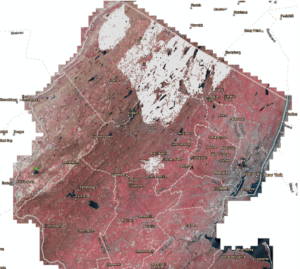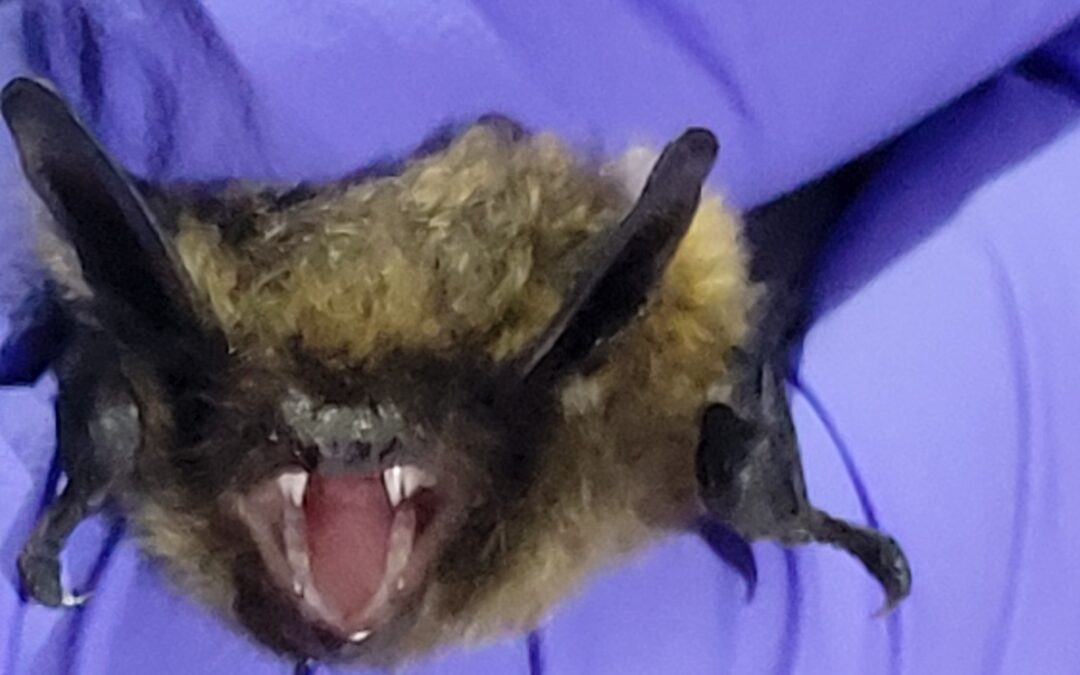Over the last two years, Merrill Creek Reservoir (MCR) staff have been working with the Conserve Wildlife Foundation of New Jersey (CWF) and NJDEP Fish and Wildlife’s Endangered and Nongame Species Program to determine what bat species are present at the property. Of particular interest to CWF and NJDFW was whether MCR has occupied habitat for the Eastern small-footed bat (Myotis lebeii).
According to CWF, “Eastern small-footed bats (Myotis lebeii) are considered rare across their range, and the species is currently proposed for endangered listing in New Jersey as their hibernation behavior puts them at risk of white-nose syndrome. Range maps generated from the state’s Biotics database limit the occurrence area for E. small-footed bats to highly concentrated portions of Sussex, Morris, Passaic, Bergen, and Somerset counties, though this may not be comprehensive as the species is elusive and challenging to survey. While many gaps exist in the literature surrounding their ecology and life history, it is generally accepted that they associate with open, rocky habitats like talus slopes and cliff faces with nearby water sources, and they prefer elevations of 200-800 m. Foraging typically occurs in forested areas close to roost sites. Initial examination of aerial imagery and topographic data has identified potentially suitable habitat within New Jersey’s Ridge and Valley, Highlands, and Piedmont regions that are not currently included in the species’ known distribution.” Merrill Creek Reservoir was suggested to be a site that could potentially harbor E. Small-footed bats given its elevation and presence of many exposed large rocks which were used in the construction of the main dam and dikes around the reservoir.
Initial surveys involved deploying acoustic detectors at suitable habitats across the MCR property. Acoustic detectors are a minimally invasive way to begin to understand the presence and diversity of species within an area of interest as they record; specifically, they detect the ultrasonic echolocation calls of bats and converting them into audible sounds for humans to hear. These devices use specialized microphones to capture the high-frequency calls and then either directly translate them into audible frequencies or record them for later analysis. However, they are not foolproof, particularly for myotis species which have overlapping call characteristics. Therefore, once recorded data from the acoustic surveys are analyzed, should Eastern small-footed be detected, attempts to visually confirm the species could be done by mist-netting. As it is very difficult to determine bat species when they are in flight, mist-netting provides a method of capturing birds or bats safely for research purposes so animals can be examined close-up (in-hand so to speak). The mist nets are made of fine, nearly invisible mesh, suspended between poles, and designed to gently entangle flying animals as they pass through.
Results from both the 2024 and 2025 acoustic survey indicated several bat species at MCR, including Eastern small-footed bat. This is the first time that this species was found at MCR, and in Warren County for that matter. Therefore, in July 2025, staff from CWF, NJDFW and MCR implemented mist-netting at MCR and on the first inspection of the nets, a male Eastern Small footed bat was caught! The bat was safely removed from the net, examined and measurements were taken by CWF and NJDFW.

In Gray on the map is the known confirmed range of Eastern Small-footed Bat in NJ. The Green Dot on the map is the location of Merrill Creek Reservoir where the species has now been confirmed on site.
The confirmation of Eastern small-foot bat at MCR is significant in that Merrill Creek Reservoir is about 30 miles from the next closest capture in southern Morris County. So, this discovery extends what NJDFW know to be their range in NJ! Additionally, given the atypical specific structure that the E. small-footed bat uses for roosting, (i.e. under rocks and rock talus rather than in caves, mines, trees, buildings or bridges), the construction of MCR with its use of the rock that was blasted/excavated from the ground for the reservoir and used to create the dam and dikes apparently has benefited E. small-footed bat!
MCR would like to thank CWF and NJDFW’s Endangered and Nongame Species Program for their fine work on this research and we look forward to working with them to help ensure this species’ place in NJ’s natural heritage!


